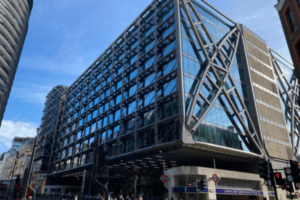Could it be that their voices are but mere whispers in the annals of history?
Enter Boudicca, the indomitable warrior queen of the Iceni tribe, whose tale escaped the realm of legend and was granted empirical veracity thanks to excavations at 1 Poultry in the 1990s.
The Layers Below
The Mappin and Webb building, which once stood at 1 Poultry, gave way to a contemporary edifice designed with Rhubarb and Custard stripes. But its demolition opened a gateway to the ancient past. In the recesses of the Walbrook, a stream that once bisected Londinium, archaeologists unearthed a plethora of Roman artefacts, including writing tablets and assorted relics. Among these discoveries was a layer of soil distinct from its surroundings. Laboratory tests dated this soil stratum to circa 60 AD, a chronological clue that it bore witness to Boudicca’s uprising.
Betrayal and Boudiccan Revolt
The Iceni, under the governance of Boudicca’s late spouse, Prasutagus, initially cohabited amicably with the Romans during Emperor Claudius’s rule. Prasutagus’s demise altered the landscape; instead of honouring his will—which bequeathed the kingdom to his daughters—the new Roman regime reneged on the agreement. This betrayal led to a series of atrocities against the Iceni, compelling Boudicca to mount a ferocious revolt. She first targeted Camulodunum (now Colchester), before setting her sights on Londinium. Historical sources portray her onslaught as both unremitting and ruthless.
The Sword of Justice and the Scale of Ethics
It is tempting to romanticise Boudicca as an emblem of resistance, yet we must scrutinise the ethical complexity of her methods. Her revenge was indiscriminate, claiming the lives of non-combatants in addition to Roman soldiers. A balanced understanding of history obliges us to confront its complexities, including its less palatable aspects.
The Iceni Defeat and Boudicca’s Demise
The returning Roman legions from the Anglesey campaigns ultimately subdued the Iceni rebellion. Boudicca, in the final act of defiance, is said to have ingested poison to evade capture, thereby consigning the fate of her daughters to the mists of antiquity.
Conclusion: Boudicca’s Legacy and the Shaping of London
The exceptional layer of soil excavated at 1 Poultry grants Boudicca her rightful standing in London’s narrative tapestry. It serves as an eloquent testament to the long-forgotten voices that are as much a part of London’s rich history as its grand monuments and celebrated figures.
For those eager to explore the multi-layered past of London, a walking tour centred on pioneering women offers an engaging lens through which to view the city. So, whether you are a resident or a visitor, seize this opportunity to engage with the intricacies of a London often left undiscovered.
Book a Pioneering Women in the City walking tour


